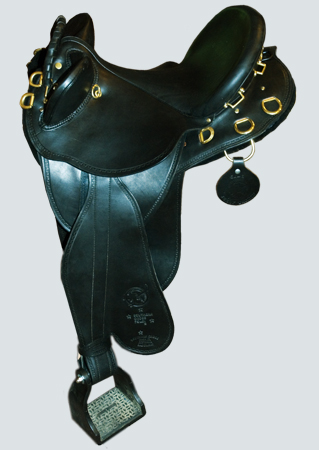|
By Jerry Tardif

|
Many of us like the feeling of a good leather saddle under us.
And we usually like to match that with a good leather bridle, and perhaps similar reins, martigales, and what have you.
The cost of such tack can be very expensive, and we cringe at the thought of it getting wet, or worse, soaked.
But mistakes and accidents do happen, and trail riders especially risk getting caught in the rain.
If that should happen to you, don't despair, the chances of you saving your saddle and other tack are good if you act quickly and appropriately.
|
|
One More Very Important Point:
It would be sad to have soaked your saddle from a sudden rain or an unanticipated roll at a pond by your horse, and then ruined the tack yourself after the fact by taking the wrong actions in an ill-fated attempt to save your saddle.
Also, don't ignore your saddle till your next ride — you need to save it by taking the proper actions while it's still wet.
Here's what you should do:
- First, DON'T use a hair dryer and DON'T place your saddle in the Sun or in an oven — let it air-dry slowly.
Using some form of heat can cause the leather to crack;
- DON'T leave your saddle in a humid location, such as a basement.
Keep your saddle in a dry and shady place, such as under a car port or in a garage with an open door to promote air circulation;
- Ideally, place the saddle on a wooden or plastic saddle rack to lift it up and let air circulate underneath as well as not to let it dry into a different shape because it isn't properly supported; don't just lie it on the floor or on a table without being on some form of stand that conforms to its bottom shape.
You don't want the saddle's flocking to get compressed or otherwise let the saddle lose its shape;
- Dry the saddle as completely as you can with clean, dry towels.
Try to remove as much excess water as you can and use as many towels as necessary;
The drenching rain has washed out some of the tanning oils that were in the saddle.
Those oils preserve the saddle and help keep damaging moisture away from the leather fibers.
Conversely, water promotes mold and mildew which actually grow on the saddle and push roots and tendriles into the leather breaking it down and destroying it; and
- Once the saddle is just damp, but before it fully dries, RUB some good quality leather conditioner (e.g. Leather Therapy) into the saddle as it further dries.
The conditioner will help displace the remaining moisture and make the leather soft again.
Waiting until it fully dries would make the leather brittle and easily subject to cracking — that would ruin the leather.
The keys to this whole process are to act quickly, remove excess water, and not let the leather dry completely nor too quickly.
Your goal must be to reverse the process of losing oils that had been applied during the tanning process.
If the saddle does dry completely before you start replacing the water with the conditioning oils, the leather will never be as strong as it was before the drenching.
It may be as soft as it was, but it likely will not be as strong when stressed as it would have been.
In addition, if you keep your tack properly oiled during its entire life, you reduce the leather's ability to absorb water.
That means you should clean and oil your saddle regularly after every few rides at most.
Finally, keep your saddle in a clean, dry, location that is not subject to sweltering heat or freezing cold.
Leather products do best in the same climate that we enjoy in our homes.
Unfortunately, that means that many tack rooms ARE NOT the best place to keep our leather tack.
Tack rooms are often not heated or air conditioned.
The situation is even worse in barns with dirt floors because the dust floats into the tack room and onto our tack.
Over time, humidity and perspiration mix with the dust to form a grime that is ground into the saddle.
Good luck!
Besides being an avid trail rider, Jerry Tardif is a technology consultant and a horse and nature photographer in SE Connecticut — see his work at: www.jerrytardif.com.
He is also co-founder and President of QueryHorse.
Back to Article Index
|